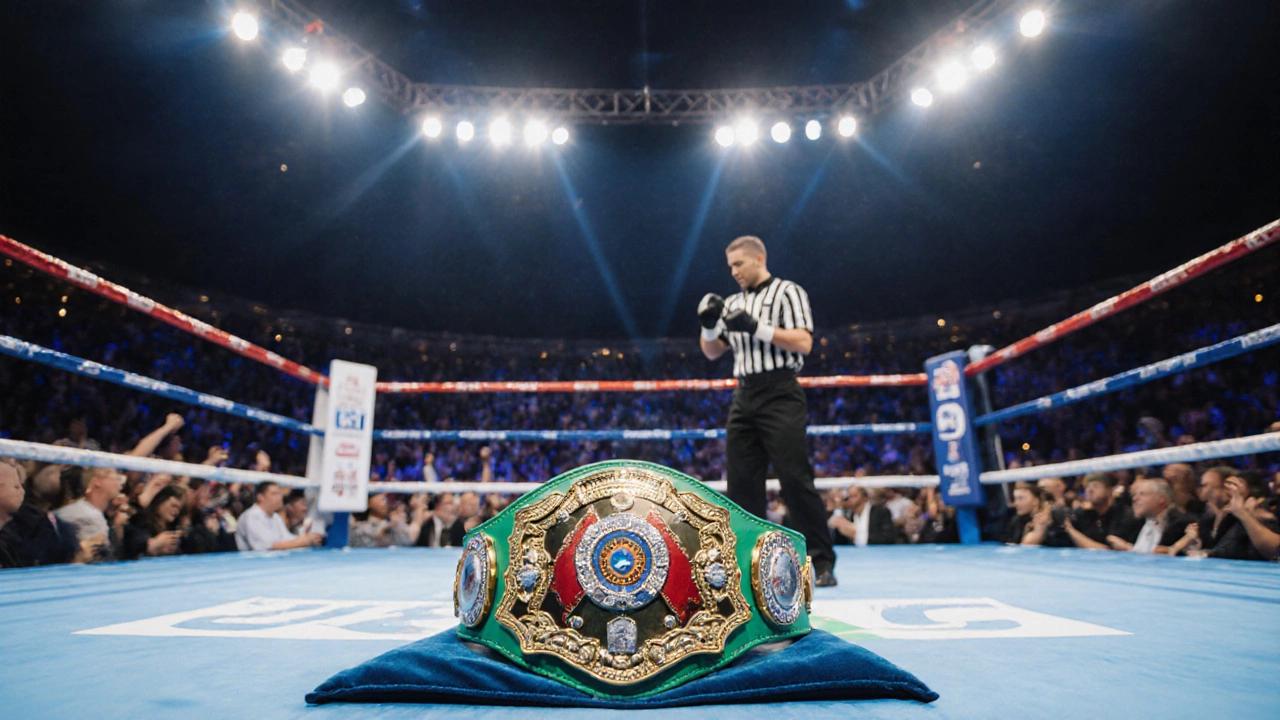Boxing Title Match Explained: What It Means & How It Works

Quick Takeaways
- A title match is a bout where a championship belt is on the line.
- Sanctioning bodies (WBC, WBA, IBF, WBO) set the rules and award the belts.
- Only fighters ranked by those bodies, or mandatory challengers, can contest a title.
- Title matches are longer (12 rounds), offer higher purses, and affect a boxer’s legacy.
- Types include unified, undisputed and interim title fights.
What Exactly Is a Title Match?
In boxing, a title match is a fight where a recognized championship belt is at stake. It’s not just another bout on the card - it’s the headline event that decides who holds the official title for a weight class under a particular sanctioning body.
The word “title” refers to the official recognition granted by an organization such as the World Boxing Council (WBC) or the International Boxing Federation (IBF). When a boxer wins a title match, they become the champion of that weight division for that organization.
How Does a Title Match Get Set Up?
Getting a title bout on the calendar involves three main players: the sanctioning body, the promoter, and the fighters themselves.
World Boxing Council (WBC), founded in 1963, is one of the four major bodies. The others - World Boxing Association (WBA), International Boxing Federation (IBF) and World Boxing Organization (WBO) - each have their own ranking systems and rules.
Promoters negotiate the contract, secure a venue, and sell tickets. They also pay a sanctioning fee to the governing body, which helps cover the cost of the belt and the administrative work of approving the match.
Once the promoter has a paid‑in‑full contract, the sanctioning body checks the fighters’ rankings, medical clearances, and any mandatory challenger requirements before giving the green light.
Who Is Eligible to Fight for a Title?
Eligibility hinges on three factors: ranking, weight class, and mandatory status.
- Ranking: Each sanctioning body publishes a top‑15 list. Usually the champion faces the #1 challenger, but exceptions happen for big‑money superfights.
- Weight class: Boxers must make the limit for the division -‑‑‑‑‑‑‑‑‑‑‑‑‑‑‑‑‑‑‑‑‑‑‑‑‑‑‑‑‑‑‑‑‑‑‑‑‑‑‑‑‑‑‑‑‑‑‑‑‑‑‑‑‑‑‑‑‑‑‑‑‑‑‑‑‑‑‑‑‑‑‑‑‑‑‑‑‑‑‑‑‑‑‑‑‑‑‑‑‑‑‑‑‑‑‑‑‑‑‑‑‑‑‑‑‑‑‑‑‑‑‑‑‑‑‑‑‑‑‑‑‑‑‑‑‑‑‑‑‑‑‑‑‑‑‑‑‑‑‑‑‑‑‑‑‑‑‑‑‑‑‑‑‑‑‑ of the division (e.g., lightweight is 135 lb).
- Mandatory challenger: Some bodies enforce a “mandatory” defense every 12‑18 months. If a fighter holds that mandatory slot, the champion must either fight them or risk being stripped.

What’s at Stake Beyond the Belt?
Winning a title match does more than put a belt around your waist. It boosts a boxer’s marketability, earning potential, and bargaining power for future fights. A champion typically commands a larger share of the purse -‑‑‑‑‑‑‑‑‑‑‑‑‑‑‑‑‑‑‑‑‑‑‑‑‑‑‑‑‑‑‑‑‑‑‑‑‑‑‑‑‑‑‑‑‑‑‑‑‑‑‑‑‑‑‑‑‑‑‑‑‑‑‑‑‑‑‑‑ often 60‑70% of the total.
The legacy angle matters too. History books list champions by name, not by the number of regular bouts they fought. Being a title holder opens doors to sponsorships, media appearances, and, for some, a Hall‑of‑Fame induction.
Types of Title Matches
Not every title fight looks the same. Here are the most common variations:
- Standard title bout: Champion vs. challenger for a single organization’s belt.
- Unified title fight: Two or more belts from different bodies are on the line in the same fight.
- Undisputed title bout: All four major belts (WBC, WBA, IBF, WBO) are contested, making the winner the sole champion of the division.
- Interim title fight: Held when the champion is unable to defend (injury, suspension). The interim champion may later be forced to fight the returning champion.
Rules That Set Title Matches Apart
While the core rules of boxing remain unchanged, title fights add a few extra layers:
- Number of rounds: Title bouts are usually scheduled for 12 three‑minute rounds. Non‑title fights often run 10 rounds or fewer.
- Glove size: Many sanctioning bodies require smaller gloves (8‑10 oz) for title fights, which can increase punching power but also risk of cuts.
- Judging criteria: Scoring is stricter. Judges are reminded to prioritize clean, effective punches and ring generalship.
- Medical inspections: A comprehensive pre‑fight medical panel, including MRI or CT scans, is mandatory.
- Financial guarantees: The promoter must escrow a portion of the purse and the sanctioning fee to protect the fighters.
These differences aim to ensure the champion truly proves themselves against the best competition.
Comparison of the Four Major Sanctioning Bodies
| Organization | Founded | Typical Belt Color | Ranking Scope (Top) |
|---|---|---|---|
| World Boxing Council (WBC) | 1963 | Green | #15 |
| World Boxing Association (WBA) | 1921 | Gold | #15 (Super & Regular) |
| International Boxing Federation (IBF) | 1983 | Red | #15 |
| World Boxing Organization (WBO) | 1988 | Silver | #15 |

Common Misconceptions About Title Matches
People often think a title fight automatically means a knockout or a super‑star bout. In reality, many title matches go the distance and are decided by a split decision. Also, a fighter can hold a “vacant” title -‑‑‑‑‑‑‑‑‑‑‑‑‑‑‑‑‑‑‑‑‑‑‑‑‑‑‑‑‑‑‑‑‑‑‑‑‑‑‑‑‑‑‑‑‑‑‑‑‑‑‑‑‑‑‑‑‑‑‑‑‑‑‑‑‑‑‑‑ when the previous champion retires or moves weight classes.
Another myth is that any champion can defend against anyone. Mandatory challengers, contractual clauses, and even politics can shape who steps into the ring.
Tips for Fans Watching Their First Title Match
- Check the fighters’ rankings on the governing body’s website -‑‑ it tells you why the bout matters.
- Notice the round length; title fights have 12 rounds, so stamina becomes a big factor.
- Watch the judges’ scorecards after each round if the broadcast provides them -‑‑ you’ll see how close the fight really is.
- Listen for the announcer mentioning “mandatory challenger” or “unified title” -‑‑ those terms signal extra stakes.
- Keep an eye on the belt itself. Each organization’s belt design is unique and often includes the champion’s name after the fight.
Frequently Asked Questions
What does “title holder” mean?
A title holder is the boxer who currently owns a championship belt for a specific weight class under a particular sanctioning body. They are recognized as the official champion until they lose the belt, move weight classes, or are stripped for violating rules.
How often must a champion defend their title?
Most bodies require a defense at least once every 12‑18 months. If a champion skips a mandatory challenger, the organization can strip the belt.
Can a boxer hold two titles at once?
Yes. When a fighter wins belts from two different bodies in the same weight class, it’s called a unified title. Holding all four major belts makes them undisputed.
What’s an interim title?
An interim title is awarded when the reigning champion can’t defend due to injury, legal issues, or other reasons. The interim champion is usually required to face the returning champion later.
Do title matches always have larger purses?
Generally, yes. The presence of a belt, higher TV rights fees, and sponsor interest mean the total purse is bigger, and champions usually claim a larger share than the challenger.
Wrapping It Up
If you’ve made it this far, you now know that a boxing title match isn’t just a fancy name -‑‑ it’s a regulated, high‑stakes contest that crowns a champion, reshapes careers, and fuels the sport’s drama. Next time a banner reads “World Title Fight,” you’ll understand the rankings, the bodies, the money, and the pride behind every jab and hook.
